How to Make Elderberry Syrup with Fresh or Dried Berries
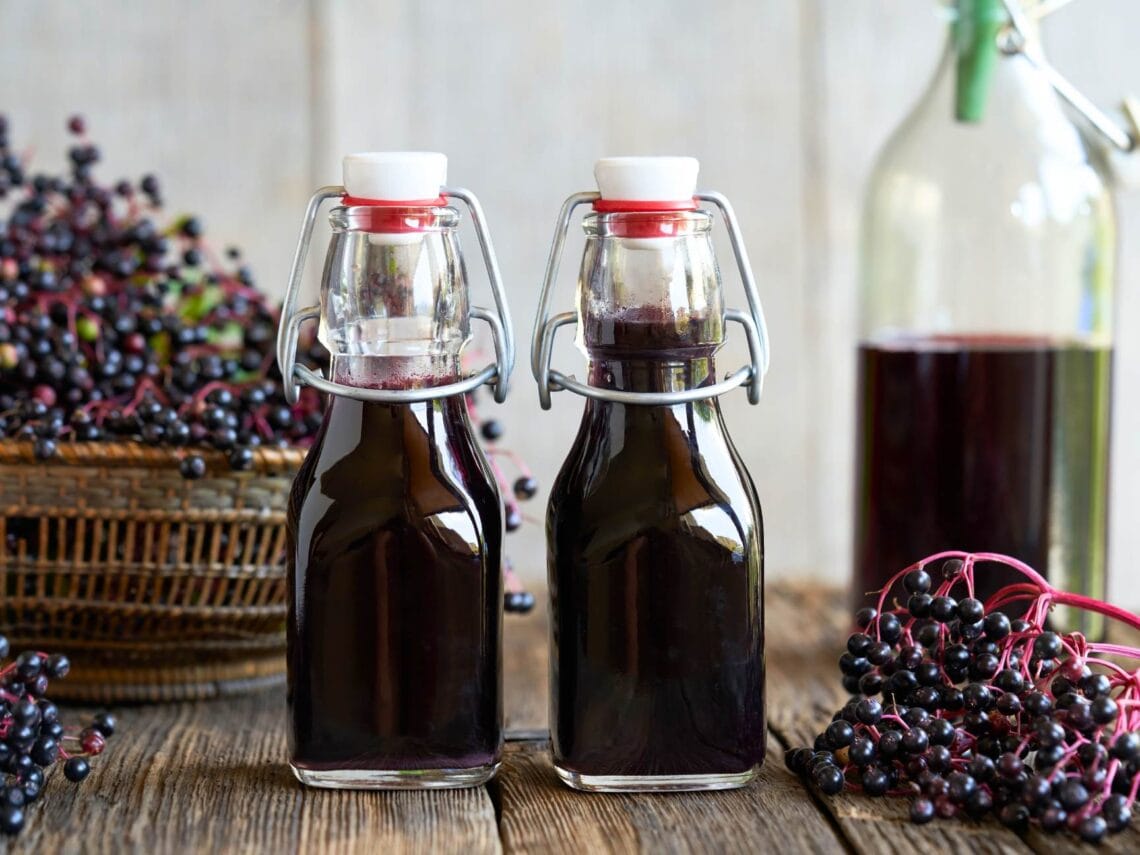
Looking for some natural immune system support? Come learn how to make delicious homemade elderberry syrup with this easy step-by-step recipe. Elderberries can help prevent illness, soothe cold, flu and allergy symptoms, and promote a quick recovery when you’re feeling crummy. It tastes so good, the kiddos will love it too! Sharing bottles of elderberry syrup is also a fantastic DIY gift idea for the holiday season.
We’ve been making this elderberry recipe for many years, adapted from the queen-of-herbs Rosemary Gladstar’s book Medicinal Herbs: A Beginner’s Guide. You can make elderberry syrup using dry, frozen, or fresh elderberries, so I’ve included instructions for all options.
This post was originally published in February 2019.

Would you like to save this?
Disclosure: Homestead and Chill is reader-supported. When you purchase through links on our site, we may earn an affiliate commission.
RELATED: Don’t miss our elderberry gummies recipe, fire cider recipe, homemade cough drops with honey and ginger, or this delicious fermented garlic honey recipe!
The History of Elderberry
Known in the botanical world as Sambucus Nigra, elderberry has been used for centuries by traditional cultures and herbalists in natural medicine, both early in Europe and later in North America. Native Americans used the plants bark and leaves to make poultices to heal bruises and sprains, and internally to rid themselves of parasites. Now, the bark and leaves are not used as commonly in modern natural medicine due to its content of cyanide.
Safety precautions with fresh elderberries
There are several types of elderberries native to North America and Europe. The blue-black varieties are used for medicinal purposes (Sambucus Nigra). The varieties with red berries (Sambucus racemosa) are toxic and should be avoided.
Also, while there are no studies showing that elderberry is harmful during pregnancy, there is also a lack of studies to prove that it is safe. According to PubMed, “health care personnel should not advise pregnant women to use echinacea or elderberry against upper respiratory tract infection.”
Finally, please note that it is only safe to consume cooked, ripe, fresh elderberries (or dried). Other parts of the elderberry plant contain cyanide, including the stems or leaves – so be sure to thoroughly remove all the stems! Even pruning our elderberry plant gives me a rash. Raw, uncooked, or unripe berries will also likely cause an upset stomach and uncomfortable side effects. Considered “cooked”, dried berries do not pose the same risk.

Health Benefits of Elderberry Syrup
Combining the benefits of both elderberries and honey, elderberry syrup is a powerful natural cold and flu preventative and healer. Our elderberry syrup recipe also includes ginger, cinnamon, and other spices – making it extra therapeutic, and extra delicious!
Studies show that elderberries have antiviral and antimicrobial properties, helping to prevent illness as well as shorten and alleviate symptoms of the common cold. It’s full of antioxidants, vitamins, minerals, and amino acids that strengthen your immune system, cardiovascular system, and more. Elderberry syrup is also reported to help ease the symptoms of seasonal allergies.
Thick and sweet, honey is excellent at soothing sore throats and naturally suppressing coughs. Like elderberries, raw honey is also highly antimicrobial and loaded with antioxidants. Honey can help ward off internal pathogens when ingested, and can even be used topically to heal wounds too!
Health benefits aside, there are a number of other perks to making your own elderberry syrup at home. It’s fun and easy to do, and the end result is a nutrient-dense natural supplement for the fraction of the cost of buying it at the store!
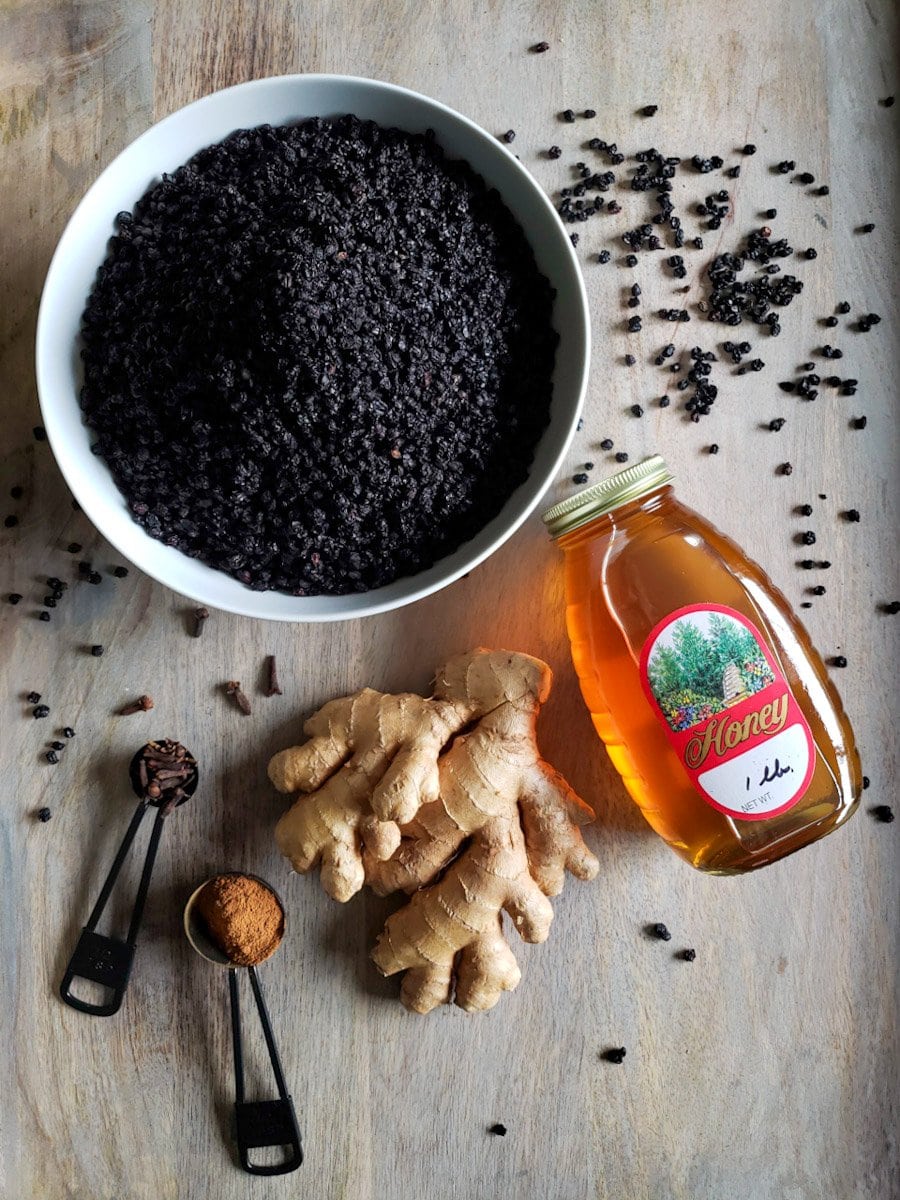
Ingredients and Supplies
This recipe yeilds approximately 40 ounces of elderberry syrup.
- 4 cups of dried organic elderberries OR 8 cup fresh, ripe organic elderberries (or frozen berries). We usually use these organic dried elderberries. One bag is plenty to make this recipe.
- Honey, 16 to 24 ounces. Honey is best for immunity though you could substitute with agave or maple syrup to make vegan elderberry syrup.
- 2 tablespoons of grated raw fresh ginger or 1 tsp ground
- 1 teaspoon of cinnamon powder OR 2 whole cinnamon sticks
- 1/2 teaspoon cloves (whole or ground)
- Optional: 2 to 3 whole star anise
- Optional: a splash of whiskey, vodka, or other alcohol (to help extend the shelf life)
- Water
- Cheese cloth or a nut milk bag to strain the berries
- Air-tight glass storage containers for the finished elderberry syrup, such as 8 oz swing top bottles, 16 oz glass bottles, or mason jars.
Another option is to get a convenient all-in-one DIY elderberry syrup kit like this one from TC Elderberry. It includes organic dry elderberries, cinnamon sticks, and other spices. All you have to do is brew it with water and add honey. Their “kicked up” version also has echinacea, rosehips and aronia berries for an added boost! They also offer finished syrup – made fresh to order. Use code “deannacat” to save 15% at TC Elderberry.

Step 1: Combine Elderberries and Water
Using dried berries: In a large pot or saucepan, combine 4 cups dried elderberries with 8 cups of water. Note the height of liquid in the pan.
Using fresh berries (or frozen): If you’re fortunate enough to have fresh elderberries available, use 8 cups of berries and just 1 cup of water. The natural juice in the berries will make up for the little amount of water added! Wash them and remove all the stems first. If you’re using frozen elderberries, there is no need to defrost them first.

Step 2: Add Spices
Turn the stove on a medium-low heat, enough to simmer the mixture but not boil. Once the mixture has begun to heat up, stir in:
- 1 teaspoon of cinnamon powder OR 2 whole cinnamon sticks
- ½ teaspoon of whole cloves (or 1/2 tsp powder)
- 2 heaping tablespoons of freshly grated raw ginger
- Optional: 2-3 whole star anise
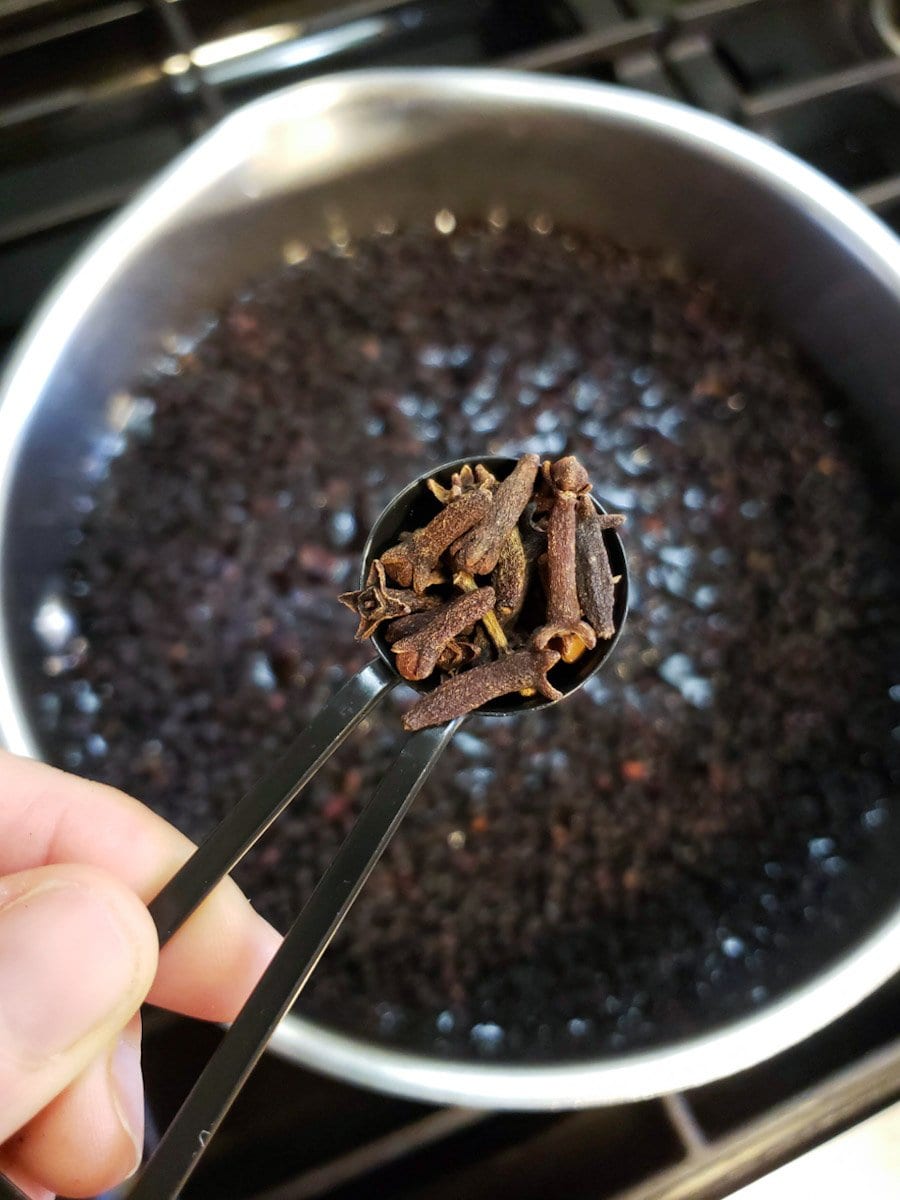
Step 3: Simmer and Reduce
Dried elderberry variation: Continue to simmer until the liquid has reduced to about half of the original volume. This could take only 30 minutes, or up to an hour or two, depending on how vigorous a simmer you set your stove to. We usually opt for slow-and-steady. As the berries soften and the water reduces, the elderberry juice becomes increasingly concentrated.
While simmering, leave the pot uncovered so steam can evaporate. Also stir the mixture on occasion. I use a large flat wood spoon to press the elderberries against the side of the pot as I stir. (Or you can use a potato masher if you have one.) This helps to squeeze out all the good juices we’re after!
Fresh elderberry variation: Simmer the berries and water for at least 30 minutes, until they’re soft and release their juices. Press and stir on occasion. Next, strain out the skins and pulp (as shown below) and return the elderberry juice to the pan. Continue to simmer until the original amount is reduced by about one-half.

Step 4: Strain
Once the liquid reduces to about half of the original volume, it is time to squeeze and strain! (If you haven’t already done that with your fresh berries in Step 3, that is.) Allow the elderberry mixture to cool slightly before proceeding, but not completely. You don’t want to burn yourself, but also want to keep the liquid warm to help dissolve the honey later.
- To strain the elderberries, we set a fine-mesh stainless steel strainer lined with either a nut milk bag or cheesecloth, set on top of a glass mixing bowl. We like this organic cotton unbleached cheesecloth.
- Gently pour some of the mixture into the strainer. I found it best to add a little at time, pressing the berries down into the strainer and cheese cloth with a wooden spoon as we went. This helped to extract as much of the precious juice as possible. Add some, smush and mash, add some, smush and mash. Continue this until all you have left in the strainer is fairly dry berry pulp, with a nice bowl of elderberry juice below.
- Next, carefully lift and close up the sides of the cheesecloth, forming a nice little sack of berries. Then squeeze the heck of out it! This will dye your hands purple for a day or two, so wear gloves if you want to avoid that.
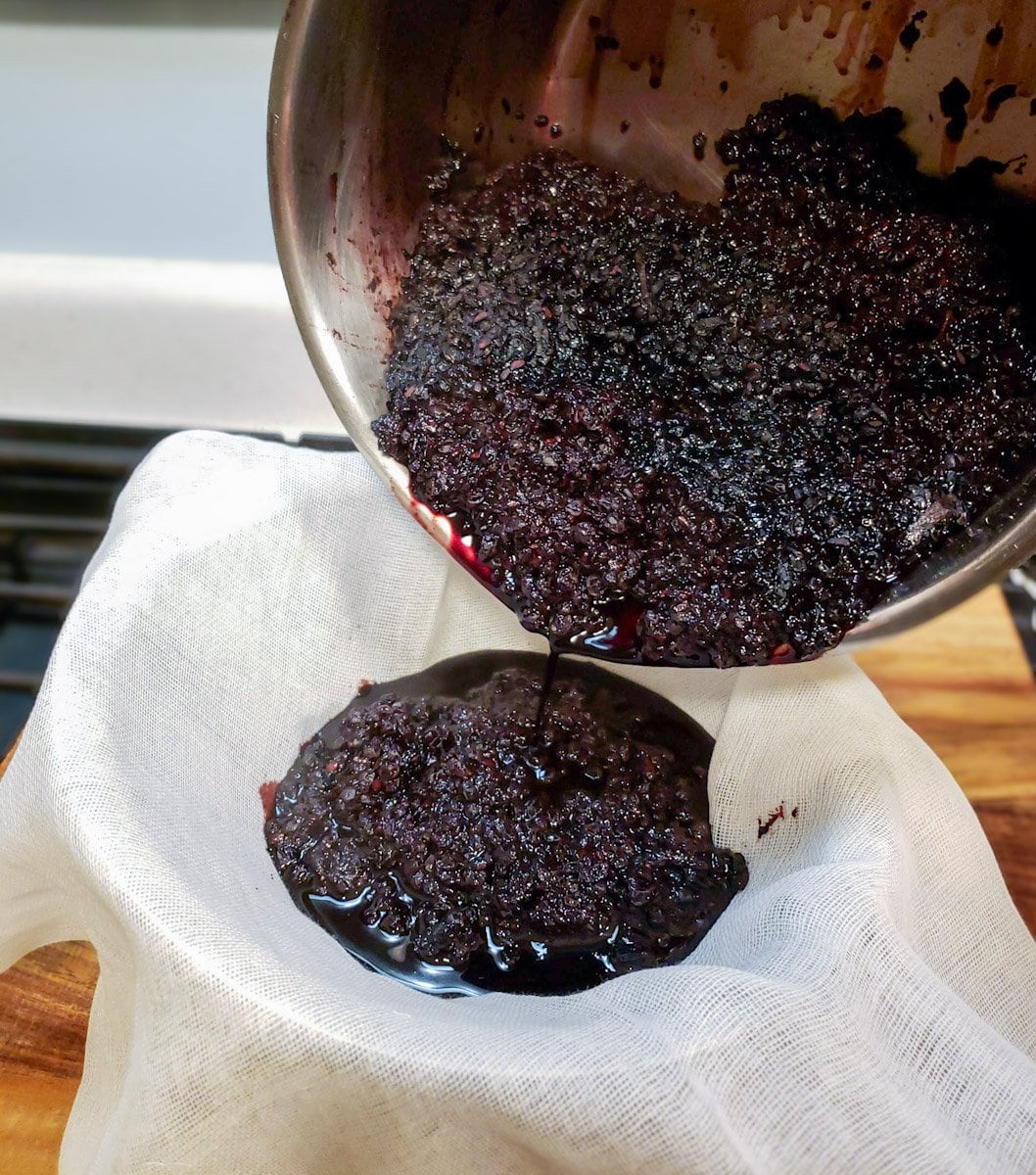
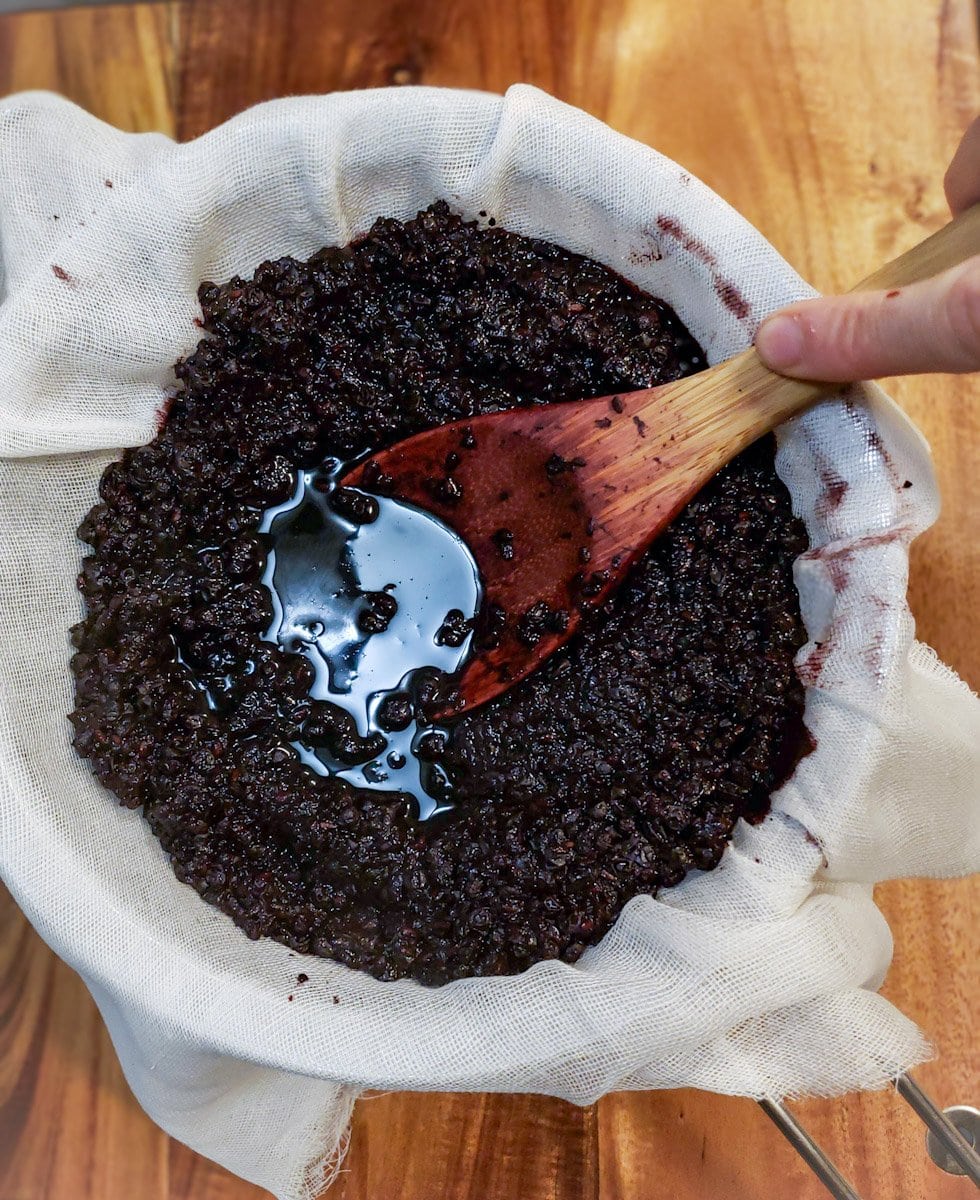

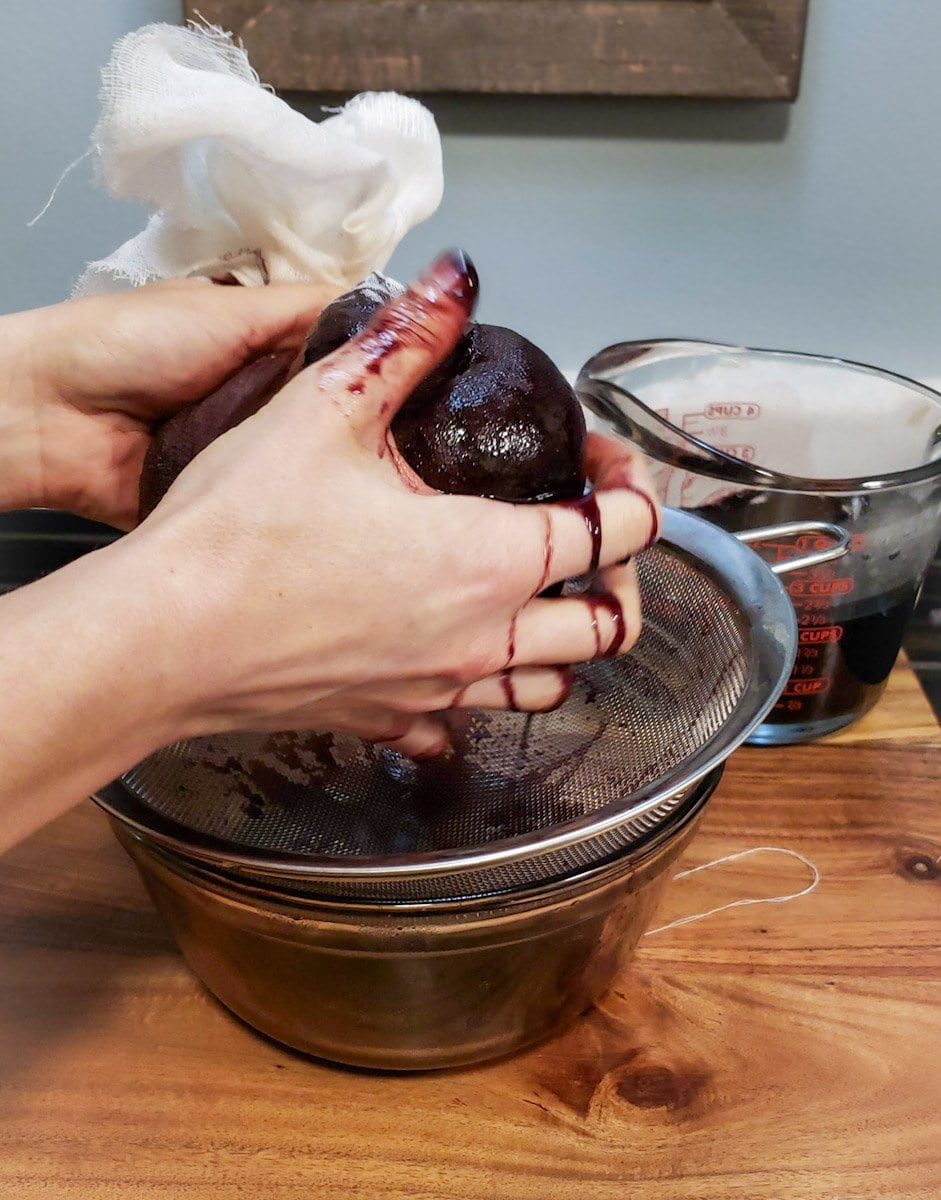
You can compost the leftover berry pulp, or steep it in water to create a dilute elderberry tea. If you have a food dehydrator, you can dry the leftover elderberries to save for future loose-leaf tea or to use in fire cider. They’ll be slightly “spent”, but should have some good stuff left inside too!

Step 5: Measure
Pour the strained, concentrated elderberry juice into a measuring cup and take note of its volume or amount (e.g. 3 cups). Now add the juice back into your pot, but do not turn the heat back on.
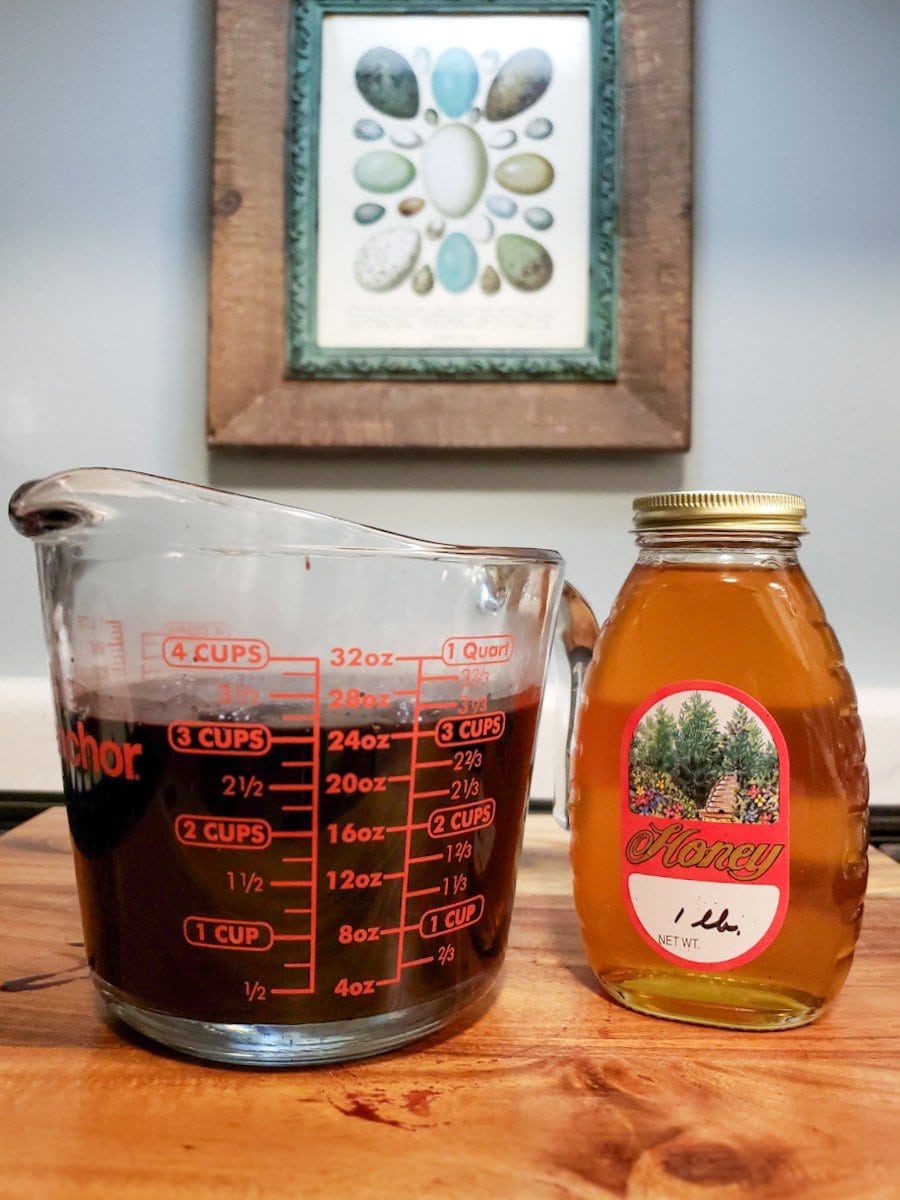
Step 6: Add Honey
Now it is time to turn your elderberry juice into syrup with the addition of honey!
Most elderberry syrup recipes say to add an equal amounts of honey to concentrated elderberry juice. For instance, 3 cups of juice and 3 cups of honey. Honey offers key healing properties of its own and acts as a preservative for the syrup.
The juice is likely still a bit warm, hopefully enough to whisk in the honey without needing to heat anything further. Avoid directly heating the honey, which can destroy its beneficial properties. If your honey is extra cold, set the sealed jar of honey in a bowl of warm water to help gently warm it up.
Since I’m Type 1 diabetic, we sometimes only use about ¾ the amount of honey – such as 16 ounces of honey to 24 ounces of elderberry juice. That’s plenty to preserve it, though we try to use it up faster than recommended just in case. (Storage and shelf life notes to follow.)
To extend the shelf life of homemade elderberry syrup, you can also add a splash of liquor like vodka, whiskey, or brandy as an extra preservative. One-third to half a cup of liquor for this size batch of elderberry syrup will do the job just fine.

Step 7: Bottle
Finally, transfer your delicious homemade elderberry syrup into final storage containers such as mason jars, glass swing-top bottles, or these rad swing-top flasks. Store in the refrigerator.
Storage
When made with the full honey-to-juice ratio, elderberry syrup should stay good for at least three months in the refrigerator. The addition of alcohol will help prolong the shelf life further too. As long as it doesn’t develop mold, off flavors or odors, it is likely still good and safe to consume even after 3 months.

How to Take Elderberry Syrup
You can take one teaspoon of elderberry syrup up to three times per day. We generally consume one teaspoon per day as a preventative measure, such as during cold and flu season or when something is going around our workplace. If we feel crud coming on or are actually sick, we increase our dose to 2 or 3 times per day.
Elderberry works to inhibit viral replication, so it is best to take it as the very first symptoms of illness appear, or soon after you’re around someone who is sick.
You can also use your elderberry syrup to make homemade elderberry gummies!

Bottoms up! I hope you found this guide to be helpful. If so, please leave a review below. Also feel free to ask any questions. Thank you so much for tuning in. Cheers to staying healthy, naturally.
You may also like:
- Fire Cider Recipe: How to Make Fire Cider for Immune Health
- How to Make Medicinal Herb Infused Oil: Two Ways
- Preserving Apples: How to Make Homemade Apple Cider Vinegar
- 10 Best Vegetarian and Vegan Supplements for Improved Health
- Calming Chamomile: How to Grow, Harvest, Dry and Use Chamomile

Homemade Elderberry Syrup (Dried or Fresh Berries)
Ingredients
- 4 cups dried organic elderberries OR 8 cups of fresh elderberries or frozen
- 2 tbsp freshly grated raw ginger OR 1 tsp powder
- 1 tsp cinnamon OR 2 whole cinnamon sticks
- 1/2 tsp cloves ground or whole
- 8 cups water OR only 1 cup, if you're using fresh elderberries
- 16-24 ounces honey
Instructions
- Add 8 cups of water and 4 cups of dried elderberries (or 8 cups fresh berries and 1 cup water) to a saucepan and simmer over medium-low heat.

- Once simmering, add cinnamon, clove, and grated ginger and continue to simmer, stirring occasionally until the liquid is reduced by half.
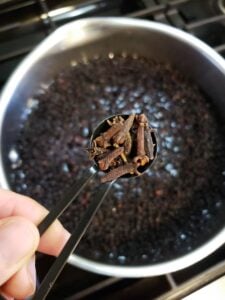
- Once reduced by half the original volume, allow the elderberry mixture to cool slightly.
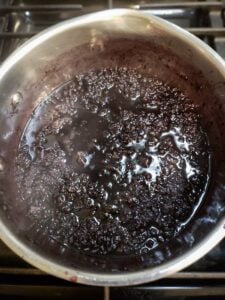
- Using a fine mesh strainer or cheesecloth perched over a bowl, strain the mixture, using a spoon (and hands) to press the berries to extract as much juice as possible.
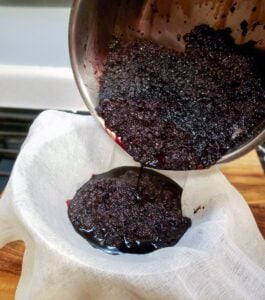
- Add the extracted elderberry juice back into the saucepan with the called-for honey, using a whisk to thoroughly combine. If needed, created a warm water bath to lightly heat and soften honey, but avoid microwaving or boiling honey!
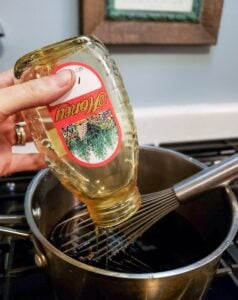
- Optional: Add a splash (up to half a cup) of your liquor of choice, as an extra natural preservative.
- Pour the elderberry syrup into jars or bottles, and refrigerate. Without liquor, it should stay fresh for about 3 months. It is safe to use until mold develops!
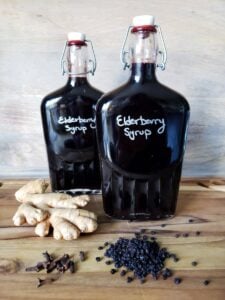






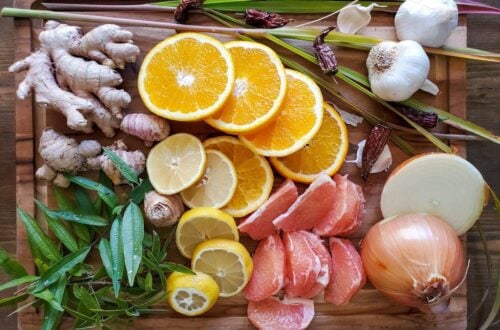
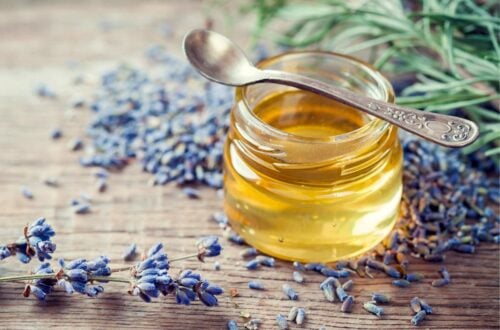
164 Comments
Jessica
Hi Deanna and Aaron!
To start, thank you so much for writing this article. I have gone back to reference it several times.
I just wanted to ADD to this article — sambucas nigra is a type of elderberry native to Europe. Here, at least on my side of the US, sambucas canadensis grows natively and prolifically. As you mentioned, it is a black-berried elderberry and is therefore medicinal. I just didn’t want people to think they couldn’t use the elderberry growing wild in their neighborhood. I am a huge advocate of native plants, so I champion “our” sambucas to anyone who will listen!
Aaron (Mr. DeannaCat)
Hi Jessica, thanks for adding to the conversation and for sharing!
Julie
Thanks for this recipe! I have a huge bag of dried elderberries. Would it make sense to blend in a vitamix after cooking to further extract more goodness? Thanks!
Aaron (Mr. DeannaCat)
Hi Julie, we have never thought to use a Vitamix for this purpose, even just cooking the dried elderberries will make them release a lot of their juices and using a blender may not be necessary, it will also add an extra step for you in the process. But if you do end up using your Vitamix, let us know how it turns out for you, good luck!
Irma Garcia
What store bought Elderberry syrup do you recommend, I don’t have the time to make it from scratch. thxs
Aaron (Mr. DeannaCat)
Hi Irma, we haven’t bought much elderberry syrup from the store but you can likely find a small tincture type bottle in the vitamin or health and wellness section in some stores. We like elderberry syrup from TC Elderberry, using the code “deannacat” at checkout should save you 15% off your order, they make it fresh in batches and it is an exceptional product. Hope that helps and good luck!
Melissa Knox
Thank you for this! I have harvested twice so far this year & are currently dehydrating my berries in the oven!! I cant eait to have enough for a batch!!!! Thank you 🙂
Aaron (Mr. DeannaCat)
That’s so great to hear Melissa! I am sure harvesting them fresh is a lot of work but it will pay off when you have all those dried elderberries to work with, great job!
Harry Fuller
Could you use a Juicer, if you have one, to extract the cooked berriers from the juice? or would that press too much pulp into the juice?
Aaron (Mr. DeannaCat)
Hi Harry, some people use a steam juicer to process fresh elderberries into juice but if you are using dried elderberries, we have found that just simmering them in water is sufficient for juice extraction. They juice is easy to separate from the dried berries but just using a fine mesh strainer and/or cheesecloth. Hope that helps and good luck!
Harry Fuller
I’m a country boy, and they grow wild here abouts, so I’ll collect them before the birds get them all, fresh off the trees/bush. thats why I asked. I gave my juicer to my daughter, but if it will not extract too much I could use it, but if it took too much pulp, and I would then still need to strain through a filter, then I won’t use it.
Aaron (Mr. DeannaCat)
I would just heat the fresh elderberries in a pot with water and strain them afterwards to separate the berries from the liquid, using a juicer is just another step and something else to clean. Good luck!
Cheska Robinson
What’s the ratio for berries and water if you’re using frozen elderberries?
Aaron (Mr. DeannaCat)
Hi Cheska, you just have to use the ratio for fresh elderberries. Good luck!
Vanessa
Could I use elderberries I freezer?
Aaron (Mr. DeannaCat)
Hi Vanessa, yes you can use your frozen elderberries for syrup.
Holly
Do you think adding Colloidal Silver for the water would extend the life of it, like alcohol would?
Aaron (Mr. DeannaCat)
Hi Holly, I would likely keep the elderberry syrup and colloidal silver separate and take each one on its own. Even without adding alcohol, the syrup can still last for awhile in the refrigerator. Hope that helps and good luck!
Erika
Can I preserve this syrup in a water bath canning method?
Aaron (Mr. DeannaCat)
Hi Erika, we never water bath can our elderberry syrup and it lasts for quite a long time in the fridge assuming you add alcohol to it. It seems people do water bath can elderberry syrup but it seems you have to follow instructions and ratios pretty closely to make it as safe as possible. Check out this article explaining how to go about safely canning your elderberry syrup. Hope that helps and good luck!
Rachel
Could I potentially freeze my syrup?
Aaron (Mr. DeannaCat)
Hi Rachel, absolutely you can freeze your elderberry syrup. This can be especially helpful if you don’t add alcohol to the syrup which does a good job of extending its shelf life in the fridge. Hope that helps and good luck!
Shirley Scott
Hi!
In the past I read a post where you have purchased Elderberry syrup from an organic vendor that you liked and trusted. Can you give me contact information? Or, are you selling any at this time?
Thanks much-Shirley
Aaron (Mr. DeannaCat)
Hi Shirley, we have a link to the company under the “Ingredient and Supplies” section and the company is TC Elderberry. They make delicious elderberry syrup to order and also offer kits to make your own. Hope that helps and good luck!